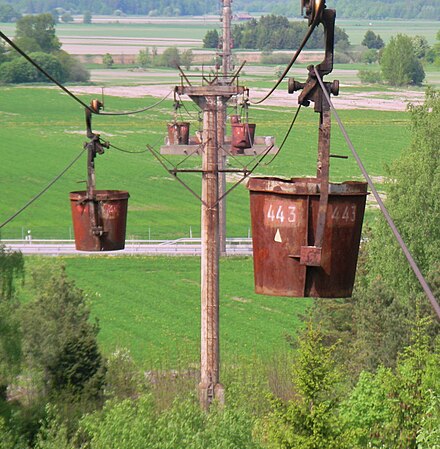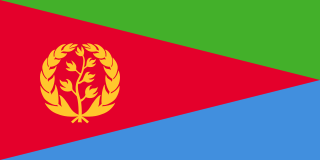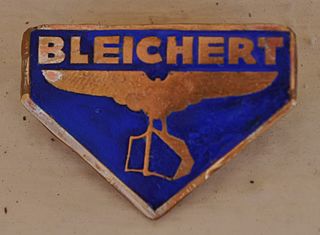

A ropeway conveyor or material ropeway [1] is essentially a subtype of gondola lift, from which containers for goods rather than passenger cars are suspended.

A gondola lift is a means of cable transport and type of aerial lift which is supported and propelled by cables from above. It consists of a loop of steel cable that is strung between two stations, sometimes over intermediate supporting towers. The cable is driven by a bullwheel in a terminal, which is typically connected to an engine or electric motor. They are often considered continuous systems since they feature a haul rope which continuously moves and circulates around two terminal stations. Depending on the combination of cables used for support and/or haulage and the type of grip, the capacity, cost, and functionality of a gondola lift will differ dramatically. Because of the proliferation of such systems in the Alpine regions of Europe, the French language name of Télécabine is also used in an English language context.
Contents
Ropeway conveyors are typically found around large mining concerns, and can be of considerable length. The COMILOG Cableway, which ran from Moanda in Gabon to Mbinda in the Republic of the Congo, was over 75 km in length. The Norsjö aerial tramway in Sweden had a length of 96 kilometers.

Mining is the extraction of valuable minerals or other geological materials from the earth, usually from an orebody, lode, vein, seam, reef or placer deposit. These deposits form a mineralized package that is of economic interest to the miner.
The COMILOG Cableway was one of the longest cableways in the world, until its closure in 1986. The ropeway conveyor ran for 76 km from Moanda in the Haut-Ogooué Province of south eastern Gabon to Mbinda in the Republic of Congo.

Moanda is one of the largest towns in Gabon, lying on the N3 road in Haut Ogooué. It is also one of the most important manganese mining towns in the world, under the auspices of the Compagnie Minière de l'Ogooué (COMILOG), which began mining in 1957. Moanda has a population of around 39,298 inhabitants and is the second largest city in the Haut Ogooué Region, after Franceville. It is also a border town, lying 100 km away from the border with the Republic of Congo.
The first recorded mechanical ropeway was by Croatian Fausto Veranzio who designed a bicable passenger ropeway in 1616. The world's first cable car on multiple supports was built by Adam Wybe in Gdańsk, Poland in 1644. It was moved by the horses and used to move soil over the river to build defences. [2]

Croatia, officially the Republic of Croatia is a country at the crossroads of Central and Southeast Europe, on the Adriatic Sea. It borders Slovenia to the northwest, Hungary to the northeast, Serbia to the east, Bosnia and Herzegovina, and Montenegro to the southeast, sharing a maritime border with Italy. Its capital, Zagreb, forms one of the country's primary subdivisions, along with twenty counties. Croatia has an area of 56,594 square kilometres and a population of 4.28 million, most of whom are Roman Catholics.

Fausto Veranzio was a Croatian polymath and bishop from Šibenik, then part of the Venetian Republic and today part of Croatia.

Adam Wybe, also known as Adam Wiebe, was an engineer and inventor of Dutch origin, active mainly in Danzig. His work includes the world's first cable car on multiple supports in 1644. It was the biggest built until the end of the 19th century.
In Eritrea the Italians built the Asmara-Massawa Cableway in 1936, which was 75 km long. The Manizales - Mariquita Cableway (1922) in Colombia was 73 km long.

Eritrea, officially the State of Eritrea is a country in the Horn of Africa, with its capital at Asmara. It is bordered by Sudan in the west, Ethiopia in the south, and Djibouti in the southeast. The northeastern and eastern parts of Eritrea have an extensive coastline along the Red Sea. The nation has a total area of approximately 117,600 km2 (45,406 sq mi), and includes the Dahlak Archipelago and several of the Hanish Islands. Its toponym Eritrea is based on the Greek name for the Red Sea, which was first adopted for Italian Eritrea in 1890.

The Italians are a Romance ethnic group and nation native to the Italian peninsula and its neighbouring territories. Most Italians share a common culture, history, ancestry or language. Legally, all Italian nationals are citizens of the Italian Republic, regardless of ancestry or nation of residence and may be distinguished from people of Italian descent without Italian citizenship and from ethnic Italians living in territories adjacent to the Italian Peninsula without Italian citizenship. The majority of Italian nationals are speakers of Italian, or a regional variety thereof. However, around half also speak another regional or minority language native to Italy; although there is disagreement on the total number, according to UNESCO there are approximately 30 languages native to Italy.

The Asmara-Massawa Cableway was a cableway built in Italian Eritrea before World War II.The Eritrean Ropeway, completed in 1937, ran 71.8 km from the south end of Asmara until the city-port of Massawa.
Conveyors can be powered by a wide variety of forms of energy, electric, engines, or gravity (particularly in mountainous mining concerns, or where running water is available). [3]














